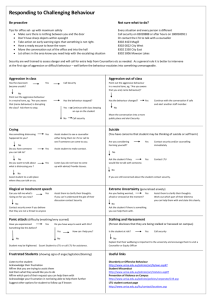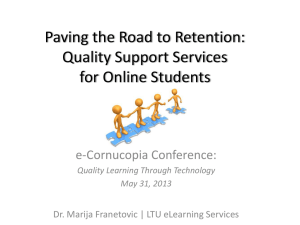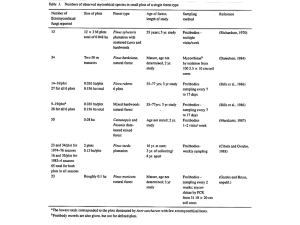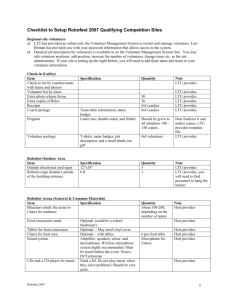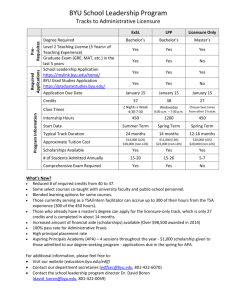Nobody Here Still but Us Orcs…
advertisement
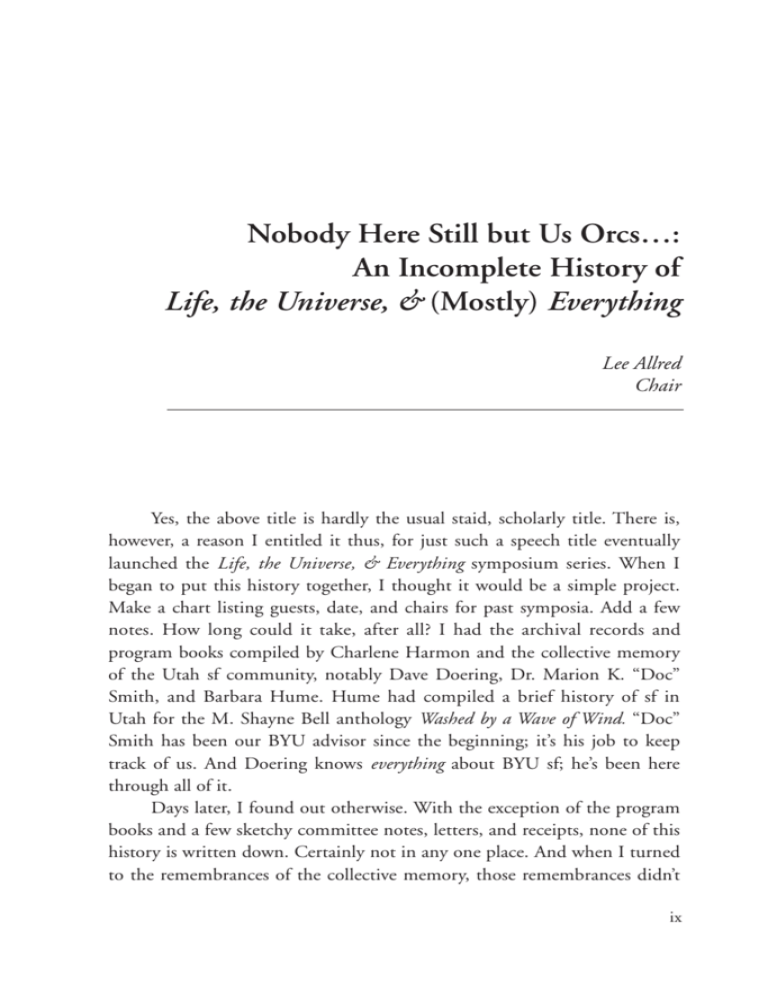
Nobody Here Still but Us Orcs…: An Incomplete History of Life, the Universe, & (Mostly) Everything Lee Allred Chair Yes, the above title is hardly the usual staid, scholarly title. There is, however, a reason I entitled it thus, for just such a speech title eventually launched the Life, the Universe, & Everything symposium series. When I began to put this history together, I thought it would be a simple project. Make a chart listing guests, date, and chairs for past symposia. Add a few notes. How long could it take, after all? I had the archival records and program books compiled by Charlene Harmon and the collective memory of the Utah sf community, notably Dave Doering, Dr. Marion K. “Doc” Smith, and Barbara Hume. Hume had compiled a brief history of sf in Utah for the M. Shayne Bell anthology Washed by a Wave of Wind. “Doc” Smith has been our BYU advisor since the beginning; it’s his job to keep track of us. And Doering knows everything about BYU sf; he’s been here through all of it. Days later, I found out otherwise. With the exception of the program books and a few sketchy committee notes, letters, and receipts, none of this history is written down. Certainly not in any one place. And when I turned to the remembrances of the collective memory, those remembrances didn’t ix LTU&E Proceedings agree one with another. Particularly on the subject of who was chair what year, especially the first three or four years. What did become apparent, however, was that LTU&E wasn’t always LTU&E—and that it has an ori‑ gin and a heritage richer and more complex than I had ever imagined. The true origins of LTU&E begin not in 1983, the year of LTU&E‑I, but in 1980. Orson Scott Card was at BYU to speak as part of the Church Sesquicentennial lecture series BYU held commemorating the 150th anni­ versary of the founding of the LDS Church. The date was March 13, 1980. The speech was entitled “Nobody Here but Us Orcs: How a Mormon Writer Deals with the Problem of Good and Evil.” The speech was only peripherally concerned with sf per se; the topic Card dealt with was morality in writing—the ethics of a good person making evil happen on the page. The paper drew more from LDS scriptures and the classics than Tolkien. I‑suspect that the only reason Card titled the speech the way he did was to‑draw in his core sf audience to get them to listen to something a bit more substantial than they were used to. Rather like sugar-coating spinach. (The speech, by the way, has been published in Card’s A‑Storyteller in Zion essay anthology as “The Problem of Evil in Fiction” with nary a titular orc in sight.) This speech about morality (and everyone who mentioned it to me remembered the morality portion of the speech and not the orcs) directly inspired the future Life, the Universe, & Everything symposium series. Those nascent sf writers attending were galvanized by an event where a serious, thoughtful, academic discussion of both morality and of writing sf had shown that such a discussion was possible. They wanted more such discus‑ sions. More such events. And, as Doering recounts, if the university didn’t or wouldn’t provide them with such events in the future, they’d create them themselves. BYU, to its credit, tried. In fact, it had already done so. It is not generally remembered today except by a few (and only fuzzily at that) that BYU had provided a precursor to LTU&E. On January 20, 1976, the BYU Library, BYU Press, and BYU English Department organized a oneday symposium called “Science Fiction: Ultimate Odyssey,” held in the JKHB lecture hall. “Doc” Smith, Dr. Marjorie Wight, and Sue Ream were involved in its inception and participated in the event. This event estab‑ lished a precedent for an sf symposium being an acceptable campus event Nobody Here Still but Us Orcs… (later to be used in good stead by the students in justifying the approval for the first LTU&E). Unfortunately, BYU at that time lacked the critical mass of sufficiently interested students to keep it going. To paraphrase Charles Fort, it wasn’t time to railroad yet. A few short years later, in 1982, it would be. On February 25, 1982, Ben Bova was invited by BYU to speak at a campus-wide Forum Assembly. Bova was scheduled to speak during the noon hour and hold an hour-long Q&A session at 2 p.m. But what to do with this strange science fiction-type for the rest of the day? The BYU English Department thrust the care and feeding of Bova into “Doc” Smith’s hands. Never slow on the uptake, “Doc” hastily called a few of his sf writ‑ ing students, including Doering, together and they held an impromptu ad hoc sf symposium. The affair ended in a late night visit to Elizabeth (Betty) Pope’s house, where Bova was presented with a handmade afghan—thus establishing a LTU&E tradition even before LTU&E was established! The successful impromptu event gave Doering and the others a taste of what they could accomplish, a glimmering of what would be involved in putting together an actual planned event, and a hunger to actually stop talking about it and do it. That last phrase in particular is a hallmark of the enthusiastic Doering, who ensconced himself (or was ensconced, depend‑ ing on who is doing the remembering) in the role of chair of the fledgling symposium committee. M. Shayne Bell was named vice chair. It was the combination of the talents of these two, I think, that made the simply ludi‑ crous impossibility of a student-run symposium on science fiction (of all things) at BYU (of all places) possible: the energetic, vivacious Doering who can cheerlead a group over seemingly insurmountable obstacles; and the thought­ful, articulate Bell who insists that sf can and should be discussed as literature and gently insists on arguing (firmly) the point with English pro‑ fessors—on their terms. And winning. It is worth noting that not only did the symposium hurdle those insurmountable odds, but that the subtitle of the first LTU&E was “A Symposium on the Impact of Science Fiction” (ital‑ ics mine). Bell’s contribution in creating an academic discussion of sf and not just another fan convention is clear. Noticed, too, is the good taste of poet and sf author Cara (Bullinger) O’Sullivan as Speaker Selection and the organization abilities of Lareena Smith as Scheduling, and that Steve Keele’s art graces the first program book (as his artwork graces this year’s poster). xi LTU&E Proceedings But LTU&E’s founders hadn’t forgotten the reason they had wanted a symposium in the first place: to have a place to where sf and morality could be discussed openly and unabashedly together. They invited Orson Scott Card back as LTU&E’s first Guest of Honor. Card echoed his previous speech in a lecture entitled “Writing, Religion, and Wrong Doing.” A lecture by Michael Reed indicates the theme was central to the founders’ planning: “Why in the World Would a Mormon Write Science Fiction?” Central, too, was the twin emphasis on not only discussing sf, but creating it as well: “How to Sell Stories,” “Informal Discussion on Writing,” and an Orson Scott Card writing workshop “Generating Ideas.” Bell’s presence can be seen: “Science Fiction as Literature,” featuring the handful of open defend‑ ers of sf then on BYU’s faculty: Smith, Ream, Wight, and Betty Pope; and “Tip of the Iceberg Fiction: Tolkien’s Suggestive Prose” by Dr.‑Steve Walker, who has been a behind-the-scenes supporter of LTU&E since the start. Present, too, from the first was LTU&E’s strong emphasis on faculty lec‑ tures on the science of science fiction, as was a singular emphasis on poetry. Also there (but far more muted than at “real” sf conventions) were various panels on the enjoyment of sf as entertainment: comics, films, games, and other media. This school’s founder, Brigham Young, exhorted that “both males and females encourage within them mechanical ingenuity, and seek con‑ stantly to understand the world they are in, and what use to make of their existence,” that “it is the business of the Elders of this Church to gather up all the truths in the world pertaining to life and salvation, to the Gospel we preach, to mechanisms of every kind, to the sciences, and to philosophy, wherever it may be found in every kindred, tongue, and people, and bring it to Zion.” I think he would be proud of the students who created a forum here at his university to do just that. The founders named this event, half-jestingly, “Life, the Universe, & Everything” (already by the first symposium panel titles were making fun of the name) after Douglas Adams’s humorous book, but like Jesting Pilate, LTU&E’s founders metaphorically walked off and “would not stay for answer.” The symposium’s title, whether by design or happy subconscious accident, reflects not only the scope of LTU&E’s panel topics, not only the scope of science fiction itself, but (if you will permit an Asian studies major the use of the phrase) the almost zen quality of the essential Mormon-ness xii Nobody Here Still but Us Orcs… of it. And of its founders and attendees, both then and today. That we were created—that existence itself was created!—for us to learn of and about life, the universe, and everything. That, in the scheme of things, we eventually will be engaged in the purpose we were created expressly for, not in mere fictional worldbuilding, but in the real thing. Our symposium has continued on since 1983 from crisis to crisis. In some years, the money has run out; in others, the would-be organizers have done the running out. Students graduate, move on. New students, new crops of writers rise up to take their place. Yet, through it all, the echoes of that seminal Orson Scott Card sesquicentennial speech ring on in this, the sesquidecennial year of LTU&E. And like Card, who sugar-coated his mes‑ sage with references to Orcs, we here today sugar-coat through the literature of science fiction that which holds deepest meaning in our hearts: life, the universe, and…everything. xiii LTU&E Proceedings xiv Nobody Here Still but Us Orcs… xv LTU&E Proceedings xvi Nobody Here Still but Us Orcs… xvii LTU&E Proceedings Notes 1Includes Special, Category, and Participating Guests. the passing of time, fading memories, and incomplete records, this list may be incomplete or inaccurate. Full chairs and cochairs listed only; the existing record of vice chairs is even more unreliable. 3“Science Fiction: The Ultimate Odyssey” was an event organized by a threeway arrangement with BYU Press, BYU Library, and representatives of the BYU English Department (Dr. Marion K. “Doc” Smith, Marge Wight, and Sue Ream). Smith recounts that “a year or more passed before the first LTU&E was held, but I don’t recall whether it was named as such then or whether it was held continu­ously hereafter. Something in my mind says it was, but something else says we may have skipped a year.” Best estimates placed it at 1981, the “missing” year between OSC’s address and Ben Bova’s appearance, but memories ranged from 1976 to 1982. After consulting Marge Wight’s diary, the actual date turns out to be January 20, 1976. The event sets an important precedent of BYU hosting an sf symposium. Unfortu­ nately, the initiative taken by sf ’s supporters on the faculty lacked the critical base of support among students to continue the event. That base of support among stu‑ dents would begin to arrive in the next few years. 4Card appeared as part of a “Church sesquicentennial lecture series on Mor­ mon arts, letters, and sciences” held in March 1980. According to Dave Doering, Card’s speech (now published in A Storyteller in Zion [Bookcraft, 1993] as “The Problem of Evil in Fiction”) inspired the idea of creating a permanent BYU sf sym‑ posium. Doering cites this as LTU&E’s true beginning. 5The university had brought in Ben Bova to deliver a Forum address, a mid‑ day one-hour lecture to the general student body. The English Department had no idea what to do with him the rest of the day, “Doc” Smith says, so they “foisted” Bova off on him. Smith called Doering and a few others and organized an on-thespot event. 6M. Shayne Bell served as vice chair and Lareena Smith as vice chair/scheduling coordinator. 7Records for this year are nonexistent save for two different program versions. Lareena Smith and Jonathan Langford are the only LTU&E staff listed. 8As listed by the program brochure produced by James Watson and Fantas­ma­ grafix. (Front cover lists title simply as “Science Fiction Symposium: A Sym­posium on ‘1984.’”) An alternate handmade schedule lists the symposium title as “Big Brother Is Watching You: A 1984 Science Fiction Symposium.” 9Doering recalls that the first “true” LTU&E was numbered “III” on purpose. “Nobody wants to go to number one,” he says. His recollection is that previous symposiums weren’t named LTU&E. Copies of the program book for LTU&E‑I, 2With xviii Nobody Here Still but Us Orcs… however, list the title as an unnumbered “Life, the Universe, and Everything: A‑Symposium on the Impact of Science Fiction and Fantasy.” Only LTU&E II has been retro-named a LTU&E, then. 10L’Engle was not present for the regular symposium. LTU&E invited L’Engle to the February symposium, but her speaker’s fee necessitated the English Department hosting her instead later that spring. Policy prohibits LTU&E from paying speaker’s fees. Charlie Harmon recounts that Jonathan Langford “was ­personally involved in bringing L’Engle, I believe. Or he had a hand behind who­ ever did.” 11LTU&E III was supposed to be the final symposium, recounts Doering, who says that Langford urged that the series be kept going and as a result ended up LTU&E chair. 12Bradbury was not present for the regular symposium. LTU&E invited Bradbury to the February symposium, but his speaker’s fee necessitated the university itself hosting him instead in March. Policy prohibits LTU&E from paying speaker’s fees. Charlie Harmon recounts, “Bradbury we’d been working on when I left BYU in August of ’87.… We wanted to get BYU to bring him as a forum speaker.” Charlie is now unclear just precisely which group was the “we”—The‑Leading Edge magazine staff, Quark (the BYU sf club), or the English De­partment—but remembers that “Jonathan had a lot done through the English Department.” 13Michael Whelan was coincidentally invited to BYU by the Art Department during LTU&E VI. Technically he was not a LTU&E VI guest. 14After chairing two symposiums, Jonathan Langford stepped down in mid­year. A four-person committee (the “Quatarchy”) stepped in to chair VI. The Quatarchy is remarkable in several ways. First, it was the largest number of cochairs in one year; second, it actually seemed to work; third, most of the old LTU&E-ers vividly remember having a Quatarchy, but no one, including some Quatarchs, can remember who the four actually were. 15Dave Bastian recounts “Xenobia met with him [Bradbury] at Elizabeth Pope’s place because Shayne pulled some strings” and that Bradbury’s speech “had to do with jumping off cliffs and building your wings on the way down.” Rather like putting together this history. 16Cochairs Doug Cootey and Dan Willis stepped down in midyear without naming successors. LTU&E Secretary Sheila V. Schmall became unwilling chair for LTU&E X. Schmall was assisted by “shadow chair” Pat Birkedahl. 17As if the leadership crisis wasn’t enough. A critical financial shortfall almost ended the LTU&E series. According to some accounts the latter crisis caused the former. According to other accounts… 18Along with the two cochairs Parkin and Gifford, a vice chair, Rick Bick­ more, formed what was termed “the couch.” xix LTU&E Proceedings 19Rusch and Smith did not attend regular LTU&E symposium. They were instead GoHs of the writing workshop held four weeks prior to the main sympo‑ sium. The workshop drew nearly sixty registrants from eight states from Georgia to California and included many people new to both LTU&E and BYU. One regis‑ trant was even an American living in Korea at the time. 20LTU&E found itself in the odd position of having growing numbers of sf professionals ask to be guests rather than the other way around. xx
